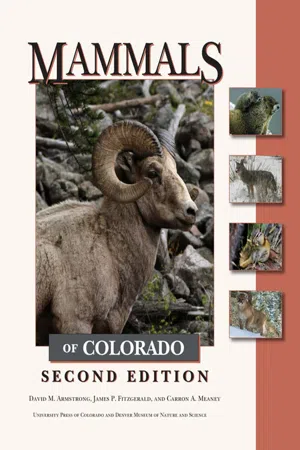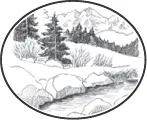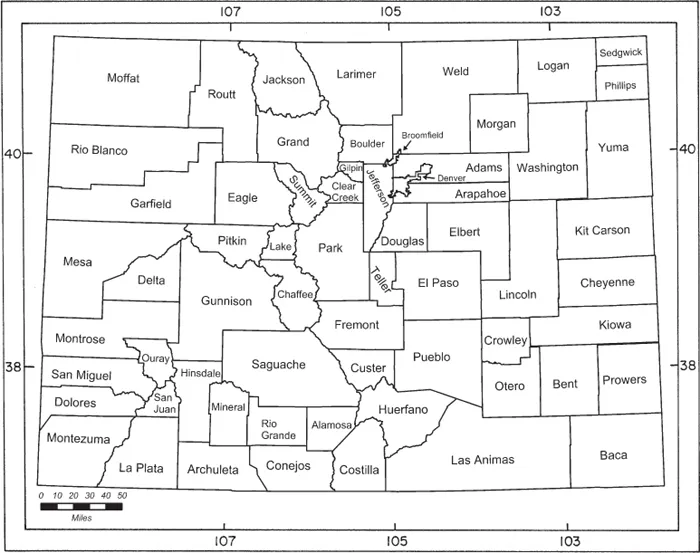
eBook - ePub
Mammals of Colorado, Second Edition
- English
- ePUB (mobile friendly)
- Available on iOS & Android
eBook - ePub
Mammals of Colorado, Second Edition
About this book
Thoroughly revised and updated, Mammals of Colorado, Second Edition is a comprehensive reference on the nine orders and 128 species of Colorado's recent native fauna, detailing each species' description, habitat, distribution, population ecology, diet and foraging, predators and parasites, behavior, reproduction and development, and population status.
An introductory chapter on Colorado's environments, a discussion of the development of the fauna over geologic time, and a brief history of human knowledge of Coloradan mammals provide ecological and evolutionary context. The most recent records of the state's diverse species, rich illustrations (including detailed maps, skull drawings, and photographs), and an extensive bibliography make this book a must-have reference.
Amateur and professional naturalists, students, vertebrate biologists, and ecologists as well as those involved in conservation and wildlife management in Colorado will find value in this comprehensive volume. Co-published with the Denver Museum of Nature & Science
An introductory chapter on Colorado's environments, a discussion of the development of the fauna over geologic time, and a brief history of human knowledge of Coloradan mammals provide ecological and evolutionary context. The most recent records of the state's diverse species, rich illustrations (including detailed maps, skull drawings, and photographs), and an extensive bibliography make this book a must-have reference.
Amateur and professional naturalists, students, vertebrate biologists, and ecologists as well as those involved in conservation and wildlife management in Colorado will find value in this comprehensive volume. Co-published with the Denver Museum of Nature & Science
Frequently asked questions
Yes, you can cancel anytime from the Subscription tab in your account settings on the Perlego website. Your subscription will stay active until the end of your current billing period. Learn how to cancel your subscription.
At the moment all of our mobile-responsive ePub books are available to download via the app. Most of our PDFs are also available to download and we're working on making the final remaining ones downloadable now. Learn more here.
Perlego offers two plans: Essential and Complete
- Essential is ideal for learners and professionals who enjoy exploring a wide range of subjects. Access the Essential Library with 800,000+ trusted titles and best-sellers across business, personal growth, and the humanities. Includes unlimited reading time and Standard Read Aloud voice.
- Complete: Perfect for advanced learners and researchers needing full, unrestricted access. Unlock 1.4M+ books across hundreds of subjects, including academic and specialized titles. The Complete Plan also includes advanced features like Premium Read Aloud and Research Assistant.
We are an online textbook subscription service, where you can get access to an entire online library for less than the price of a single book per month. With over 1 million books across 1000+ topics, we’ve got you covered! Learn more here.
Look out for the read-aloud symbol on your next book to see if you can listen to it. The read-aloud tool reads text aloud for you, highlighting the text as it is being read. You can pause it, speed it up and slow it down. Learn more here.
Yes! You can use the Perlego app on both iOS or Android devices to read anytime, anywhere — even offline. Perfect for commutes or when you’re on the go.
Please note we cannot support devices running on iOS 13 and Android 7 or earlier. Learn more about using the app.
Please note we cannot support devices running on iOS 13 and Android 7 or earlier. Learn more about using the app.
Yes, you can access Mammals of Colorado, Second Edition by David M. Armstrong,James P. Fitzgerald,Carron A. Meaney in PDF and/or ePUB format. We have over one million books available in our catalogue for you to explore.
Information
eBook ISBN
9781607320487Subtopic
Zoology1
Environments of Colorado

Mammals are a familiar and important component of Earth’s biodiversity. Biodiversity is the kinds of organisms and their genetic and ecological relationships—an evolutionary and ecological phenomenon in space and time (E. Wilson 1992). The mammalian fauna of Colorado is a fascinating piece of that whole. To understand the diversity of mammals we need to have a perspective of the ecosphere more generally. Such a perspective is the purpose of this chapter, with a focus on environments of Colorado.
Colorado is known for its scenic beauty—from majestic mountain peaks and rushing white rivers tumbling down dark canyons, to red-rock deserts and ceaselessly shifting sand dunes, to the expansive sweep of the short-grass prairie. Grandeur is wherever we stop to appreciate it, at every scale, from canyons carved in crystalline rocks 2 billion years old, to bold peaks sculpted by the glaciers of the last Ice Age, to last night’s furtive trail of a mouse across the snow. We humans appreciate ecological patterns and processes as beautiful or intriguing; to the rest of the mammalian fauna the evolving landscape represents opportunity, and native mammals respond accordingly. Thus, to understand the distribution and abundance of mammals and the details of their daily lives we must first understand the resource base, the mosaic of Colorado’s environments in space and time.
Geography
From the standpoint of political geography, Colorado is simple: it is roughly rectangular (if we neglect some minor old surveyors’ errors and the fact that Earth is spherical), measuring approximately 607 km by 444 km (377 by 276 mi.) and encompassing some 270,000 km2 (104,000 sq. mi.). Colorado lies between approximately 102° and 109° west longitude and 37° and 41° north latitude, and is subdivided into 64 counties (Map 1-1). A few of the counties are nearly natural, ecological units (e.g., Jackson, Grand, and Park counties encompass North, Middle, and South parks, respectively), but most are simply political artifacts with rectilinear boundaries.

MAP 1-1. Counties of Colorado.
From the standpoints of physical and biological geography, Colorado is anything but simple. The marvelous complexity of the scenery is the subject of this chapter, which describes environments of Colorado from several interrelated points of view. Geologic history and materials underlie environmental patterns. Physiography is the shape of the land, reflecting hundreds of millions of years of landscape evolution. Patterns of drainage reflect and produce the landforms. Vegetation integrates climate and geologic parent material in the development of soils. Plants and animals, fungi and microbes interact as biotic communities, integrated by symbioses, and they interact with the physical environment in ceaseless cycles of materials powered by a flow of solar energy. We observe—and seek to understand—an ecological whole of extraordinary complexity. But let us begin simply, with a little history.
Geology and Landforms
Colorado straddles the “backbone” of North America, the Rocky Mountains. From the mountain front, the Great Plains extend eastward toward the Missouri River. To the west lie canyons and plateaus of the Colorado Plateau and the Wyoming Basin. The juxtaposition of these major physiographic regions affects temperature, precipitation, wind patterns, and drainage.
Colorado is the highest of the United States, with a mean elevation of 2,070 m (6,800 ft.). The lowest point is 1,021 m (3,350 ft.), east of Holly, Prowers County, where the Arkansas River exits the state, and the highest point is 4,399 m (14,433 ft.), the summit of Mount Elbert, Lake County, at the top of the Arkansas watershed. Because of these varied conditions, species richness is high.
Physiographers divide most of Colorado among three “provinces” (see Fenneman 1931): the Southern Rocky Mountains, the Great Plains, and the Colorado Plateau. Northwestern Colorado is on the periphery of two additional provinces: the Middle Rocky Mountains and the Wyoming Basin. For an excellent summary of Colorado’s landforms and their development, see A. Benedict (2008).
The present-day Southern Rocky Mountains arose in a long-term event called the Laramide Orogeny, beginning some 72 million years ago, in the Late Cretaceous Period. Prior to that time (during the Mesozoic Era, the “Age of R...
Table of contents
- Cover Page
- Title Page
- Copyright Page
- Contents
- Introduction
- 1 Environments of Colorado
- 2 Mammals in General
- 3 History of Mammals and Mammalogy in Colorado
- 4 People and Wildlife Stewardship of Wild Mammals in Colorado
- 5 Order Didelphimorphia Opossums and Kin
- 6 Order Cingulata Armadillos
- 7 Order Primates Monkeys, Apes, and Kin
- 8 Order Rodentia Rodents
- 9 Order Lagomorpha Pikas, Rabbits, and Hares
- 10 Order Soricomorpha Shrews, Moles, and Kin
- 11 Order Chiroptera Bats
- 12 Order Carnivora Carnivores
- 13 Order Perissodactyla Odd-toed Hoofed Mammals
- 14 Order Artiodactyla Even-toed Hoofed Mammals
- Appendix A The Metric System
- Appendix B Glossary
- Literature Cited
- Index
- Footnote